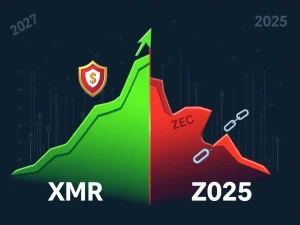Bitcoin ETFs Face *Crucial* $86M Outflow: Decoding the Impact on Crypto Investors

The world of cryptocurrency is always buzzing with activity, and recent developments in the U.S. spot Bitcoin ETFs have certainly caught the attention of investors. For the third consecutive day, these exchange-traded funds recorded a substantial net outflow, signaling a complex shift in market dynamics. On July 23, 2025, a net withdrawal of $86.04 million was observed, prompting crucial questions about investor strategies and the broader health of the digital asset market.
Understanding the Recent Bitcoin ETF Outflow
The latest data reveals a nuanced picture within the U.S. spot Bitcoin ETF landscape. While the headline points to a collective withdrawal, a closer look shows divergent performances among key players. Fidelity’s Wise Origin Bitcoin Fund (FBTC) experienced a notable redemption of $227.24 million. However, this was partially offset by significant inflows into other funds, such as BlackRock’s iShares Bitcoin Trust (IBIT), which attracted $142.48 million, and Grayscale’s Bitcoin Mini Trust (BTC), which also saw positive capital. This mixed flow indicates that while some investors are pulling back, others are reallocating or entering the market, suggesting a recalibration rather than a uniform retreat.
This sustained BTC outflow raises important questions about the immediate future of institutional engagement with Bitcoin. It underscores a period where investors are actively reassessing their positions, influenced by a confluence of factors that extend beyond simple price movements.
Why Are Investors Pulling Back? Unpacking the Drivers
The reasons behind this recent wave of withdrawals are multifaceted, reflecting the inherent volatility and evolving nature of the crypto market. Analysts point to several key drivers contributing to the current sentiment:
- Profit-Taking: Following recent price gains in Bitcoin, many investors, particularly those who entered positions earlier, are likely cashing out to secure profits. This is a natural market behavior after periods of appreciation.
- Macroeconomic Risks: Broader economic concerns play a significant role. Heightened macroeconomic risks, such as persistent inflation and the potential for the Federal Reserve to implement further interest rate hikes, can lead investors to de-risk their portfolios by moving out of more volatile assets like cryptocurrencies.
- Regulatory Ambiguities: Lingering regulatory uncertainties in the U.S. continue to be a source of caution for institutional investors. A lack of clear, comprehensive regulatory frameworks can deter long-term commitments.
- Geopolitical Tensions: Global geopolitical instability can also lead to a flight to safety, where investors opt for less risky assets or hold cash, impacting all risk-on assets, including Bitcoin.
- Stablecoin Regulatory Delays: The ongoing delays in establishing clear regulations for stablecoins can also contribute to a cautious approach, as stablecoins are often used as a bridge between traditional finance and the crypto ecosystem.
These factors collectively paint a picture of cautious investor sentiment, as market participants adapt their strategies to a dynamic global landscape.
Ripple Effects: How ETF Flows Impact the Broader Crypto Market
The impact of these ETF flows extends far beyond the performance of individual funds. When ETFs face large redemptions, especially from a significant player like FBTC, they often need to liquidate a portion of their underlying Bitcoin holdings to meet those redemption requests. This process can create increased sell pressure on the broader Bitcoin market, potentially leading to downward price movements.
This dynamic can amplify price volatility, making the market more unpredictable. Furthermore, retail investors often track institutional activity closely, and sustained outflows can negatively influence their sentiment, potentially leading to broader sell-offs. Liquidity imbalances stemming from large redemptions risk exacerbating swings in Bitcoin’s value, complicating overall market stability.
Navigating Volatility: Strategies for Prudent Investors
In a period marked by shifting sentiment and potential price fluctuations due to profit-taking and other factors, investors are advised to adopt disciplined and strategic approaches to mitigate risks. Here are some actionable insights:
- Dollar-Cost Averaging (DCA): Instead of making a single large investment, consider investing a fixed amount regularly. This strategy helps to average out the purchase price over time, reducing the impact of short-term volatility.
- Diversification: Do not put all your eggs in one basket. Diversifying across different asset classes, including traditional assets and various cryptocurrencies, can help spread risk.
- Thorough Due Diligence: Before investing in any ETF, thoroughly research its structure, fees, and the underlying assets it holds. Understand how redemptions and inflows are managed.
- Maintain a Long-Term Perspective: Short-term outflows do not necessarily signal a fundamental shift in Bitcoin’s long-term value proposition. Many believe in Bitcoin’s long-term potential as a digital store of value.
- Seek Professional Financial Advice: Given the complexity and volatility of the crypto market, consulting with a professional financial advisor is essential to align investment decisions with individual risk profiles and financial goals.
The Road Ahead: Long-Term Outlook for Spot Bitcoin ETFs
Despite the recent outflows, the long-term outlook for U.S. spot Bitcoin ETFs remains cautiously optimistic. The emergence of competitive products, such as Grayscale’s low-fee mini BTC and BlackRock’s IBIT, demonstrates a growing demand for accessible and regulated crypto exposure within traditional financial structures. These products provide a vital bridge for institutional and retail investors seeking to gain exposure to Bitcoin without directly holding the asset.
Future inflows and the overall success of these ETFs will likely depend on several critical factors: Bitcoin’s price trajectory, continued macroeconomic developments, and, crucially, regulatory clarity from U.S. authorities. As digital assets continue their integration with traditional finance, spot Bitcoin ETFs are poised to play a pivotal role in driving institutional adoption and enhancing market liquidity, solidifying Bitcoin’s place in the broader investment landscape.
The July 23 outflows underscore the dynamic nature of institutional crypto engagement. While sustained withdrawals from funds like FBTC draw attention, concurrent inflows into IBIT and BTC illustrate a nuanced market sentiment rather than a uniform retreat. Investors must remain informed and adaptable, as Bitcoin ETF flows serve as a barometer for broader market health and institutional behavior.
Frequently Asked Questions (FAQs)
Q1: What is a U.S. Spot Bitcoin ETF?
A U.S. Spot Bitcoin ETF is an exchange-traded fund that directly holds Bitcoin as its underlying asset. It allows investors to gain exposure to Bitcoin’s price movements without having to buy, store, or secure the cryptocurrency themselves. These ETFs trade on traditional stock exchanges.
Q2: Why did U.S. Spot Bitcoin ETFs experience outflows for three consecutive days?
The outflows are attributed to a combination of factors, including profit-taking by investors after recent Bitcoin price gains, heightened macroeconomic risks like inflation and potential Fed rate hikes, and ongoing regulatory uncertainties in the U.S. Geopolitical tensions and stablecoin regulatory delays also contribute to cautious investor sentiment.
Q3: Does this outflow signal a decline in institutional interest in Bitcoin?
Not necessarily. While some funds like FBTC saw significant redemptions, others like BlackRock’s IBIT and Grayscale’s Bitcoin Mini Trust experienced inflows. This suggests a recalibration of portfolios and a nuanced shift in investor strategies rather than a uniform withdrawal of institutional interest. Demand for regulated crypto exposure remains evident.
Q4: How do Bitcoin ETF outflows affect the broader crypto market?
Large ETF outflows can lead to increased sell pressure on the broader Bitcoin market as funds may need to liquidate some of their Bitcoin holdings to meet redemption requests. This can amplify price volatility and influence retail investor sentiment, potentially leading to wider market fluctuations.
Q5: What strategies can investors use to navigate this market volatility?
Investors can consider strategies such as dollar-cost averaging (DCA) to mitigate risk, diversifying their portfolios across different asset classes, conducting thorough due diligence on ETF structures, and maintaining a long-term perspective. Seeking professional financial advice is also recommended to align investments with individual risk profiles.
Q6: What is the long-term outlook for U.S. Spot Bitcoin ETFs?
The long-term outlook remains cautiously optimistic. The presence of competitive products and continued demand for regulated crypto exposure suggest a pivotal role for these ETFs in institutional adoption and market liquidity. Future success will largely depend on Bitcoin’s price trajectory, macroeconomic developments, and achieving greater regulatory clarity.










